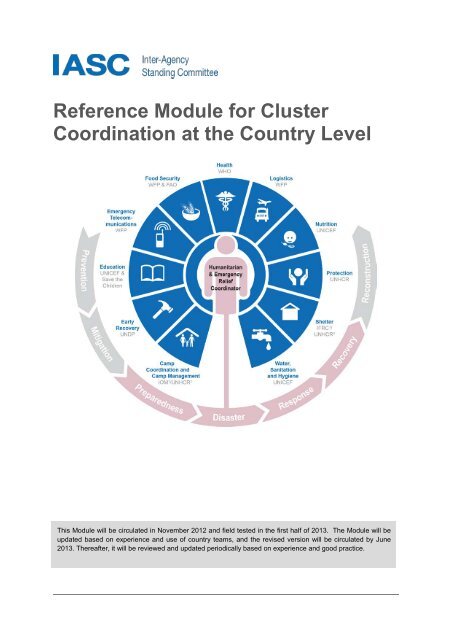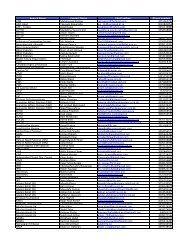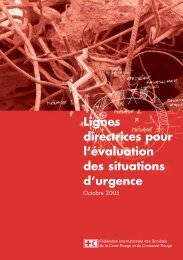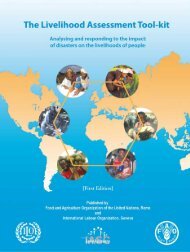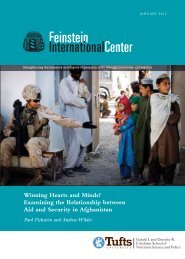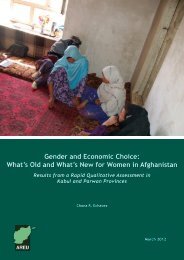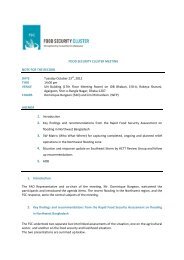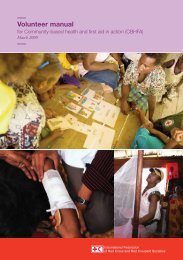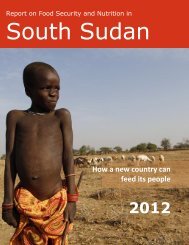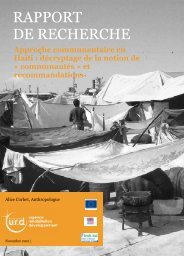IASC Reference Module for Cluster Coordination at the ... - Clusters
IASC Reference Module for Cluster Coordination at the ... - Clusters
IASC Reference Module for Cluster Coordination at the ... - Clusters
Create successful ePaper yourself
Turn your PDF publications into a flip-book with our unique Google optimized e-Paper software.
<strong>Reference</strong> <strong>Module</strong> <strong>for</strong> <strong>Cluster</strong><strong>Coordin<strong>at</strong>ion</strong> <strong>at</strong> <strong>the</strong> Country LevelThis <strong>Module</strong> will be circul<strong>at</strong>ed in November 2012 and field tested in <strong>the</strong> first half of 2013. The <strong>Module</strong> will beupd<strong>at</strong>ed based on experience and use of country teams, and <strong>the</strong> revised version will be circul<strong>at</strong>ed by June2013. Thereafter, it will be reviewed and upd<strong>at</strong>ed periodically based on experience and good practice.
Table of Contents1. <strong>Cluster</strong> Activ<strong>at</strong>ion ................................................................................................. 42 <strong>Cluster</strong> De-activ<strong>at</strong>ion............................................................................................ 63 <strong>Cluster</strong> Functions ................................................................................................. 94 <strong>Cluster</strong> Management Arrangements ................................................................. 115 Minimum Commitments <strong>for</strong> Particip<strong>at</strong>ion in <strong>Cluster</strong>s .................................... 146 Sub-N<strong>at</strong>ional Level <strong>Coordin<strong>at</strong>ion</strong> ...................................................................... 167 Sharing Leadership within <strong>the</strong> <strong>Cluster</strong> Approach .......................................... 188 Inter-<strong>Cluster</strong> <strong>Coordin<strong>at</strong>ion</strong> ................................................................................. 219 <strong>Coordin<strong>at</strong>ion</strong> Per<strong>for</strong>mance Monitoring ............................................................ 23Acronyms and Abbrevi<strong>at</strong>ions ................................................................................... 25Fur<strong>the</strong>r <strong>Reference</strong> ...................................................................................................... 26Following <strong>the</strong> recommend<strong>at</strong>ions of an independent Humanitarian ResponseReview in 2005, <strong>the</strong> cluster approach was proposed as one way of addressinggaps and streng<strong>the</strong>ning <strong>the</strong> effectiveness of humanitarian response throughbuilding partnerships. The cluster approach ensures clear leadership, predictabilityand accountability in intern<strong>at</strong>ional responses to humanitarian emergencies byclarifying <strong>the</strong> division of labour among organiz<strong>at</strong>ions and better defining <strong>the</strong>ir rolesand responsibilities within <strong>the</strong> different sectors of <strong>the</strong> response. It aims to make<strong>the</strong> intern<strong>at</strong>ional humanitarian community better organised and more accountableand professional, so th<strong>at</strong> it can be a better partner <strong>for</strong> <strong>the</strong> affected people, hostgovernments, local authorities, local civil society and resourcing partners.However, <strong>the</strong> strength of <strong>the</strong> cluster approach relies on an understanding th<strong>at</strong> thisapproach is not <strong>the</strong> only humanitarian coordin<strong>at</strong>ion solution. In some cases, <strong>the</strong>cluster approach may co-exist with o<strong>the</strong>r “non-cluster” coordin<strong>at</strong>ion solutions –whe<strong>the</strong>r n<strong>at</strong>ional or intern<strong>at</strong>ional – or an altern<strong>at</strong>ive sectoral approach may bepreferable. An indiscrimin<strong>at</strong>e applic<strong>at</strong>ion of all clusters in every emergency maywaste resources and reduce opportunities <strong>for</strong> governments to exercise <strong>the</strong>irprimary responsibility to provide humanitarian assistance to people in need.Prepared by: <strong>IASC</strong> Sub-Working Group on <strong>the</strong> <strong>Cluster</strong> ApproachEndorsed by: <strong>IASC</strong> Working Group on 31 August 2012<strong>Cluster</strong> <strong>Coordin<strong>at</strong>ion</strong> <strong>Reference</strong> <strong>Module</strong> | 2012 2
IntroductionUsing clustersintelligentlyThis <strong>Cluster</strong> <strong>Coordin<strong>at</strong>ion</strong> <strong>Reference</strong> <strong>Module</strong> 1 is about <strong>the</strong> basics of clustercoordin<strong>at</strong>ion in non-refugee situ<strong>at</strong>ions 2 . It is compiled in response to a request by <strong>the</strong><strong>IASC</strong> as a reference guide <strong>for</strong> practitioners to facilit<strong>at</strong>e <strong>the</strong> work through whichhumanitarian outcomes can be improved. It outlines key concepts and draws <strong>at</strong>tentionto existing guidance, wherever relevant. This reference module will be reviewedperiodically based on feedback from <strong>the</strong> field. This module covers both large-scaleresponses identified within <strong>the</strong> <strong>IASC</strong> Trans<strong>for</strong>m<strong>at</strong>ive Agenda 3 as ‘level 3’ 4 and smallerscale (‘non-level 3’) responses.<strong>Coordin<strong>at</strong>ion</strong> is a means to an end – <strong>the</strong> ultim<strong>at</strong>e aim of <strong>the</strong> humanitarian communityis to serve vulnerable popul<strong>at</strong>ions effectively 5 . Accordingly, <strong>the</strong> scale of intern<strong>at</strong>ionalcoordin<strong>at</strong>ion arrangements should be tailored to <strong>the</strong> oper<strong>at</strong>ional context, to supportn<strong>at</strong>ional ef<strong>for</strong>ts 6 based on existing capacity in order to direct as many resources aspossible towards delivering humanitarian assistance in a timely, predictable manner.Developing complic<strong>at</strong>ed coordin<strong>at</strong>ion arrangements should be avoided; not all clustersneed to be activ<strong>at</strong>ed in every response.The <strong>IASC</strong> Trans<strong>for</strong>m<strong>at</strong>ive Agenda recognizes <strong>the</strong> need <strong>for</strong> Humanitarian Coordin<strong>at</strong>ors(HCs), Resident Coordin<strong>at</strong>ors (RCs) and Humanitarian Country Teams (HCTs) to beempowered to make decisions th<strong>at</strong> are right <strong>for</strong> <strong>the</strong>ir own country oper<strong>at</strong>ions. Whilethis reference module focuses on <strong>the</strong> cluster approach as <strong>the</strong> principal tool availableto <strong>the</strong> intern<strong>at</strong>ional community <strong>for</strong> coordin<strong>at</strong>ing and accounting <strong>for</strong> <strong>the</strong>ir response, itfalls to <strong>the</strong> leadership of <strong>the</strong> humanitarian team <strong>at</strong> <strong>the</strong> country level to devise <strong>the</strong> mostappropri<strong>at</strong>e ‘coordin<strong>at</strong>ion solutions’ taking into account <strong>the</strong> local oper<strong>at</strong>ional situ<strong>at</strong>ion.123456This <strong>Module</strong> should be used alongside o<strong>the</strong>r guidance prepared under <strong>the</strong> <strong>IASC</strong> Trans<strong>for</strong>m<strong>at</strong>ive Agenda.UNHCR has a mand<strong>at</strong>ed responsibility to lead and coordin<strong>at</strong>e intern<strong>at</strong>ional action to refugee needs, andclusters are not established in this context.The <strong>IASC</strong> Principals reviewed humanitarian response ef<strong>for</strong>ts to several major disasters in 2010 and 2011 andpinpointed a number of shortcomings. Building on <strong>the</strong> 2005 Humanitarian Re<strong>for</strong>m, <strong>the</strong>y agreed to a set ofactions in December 2011, referred to as <strong>the</strong> <strong>IASC</strong> Trans<strong>for</strong>m<strong>at</strong>ive Agenda which focused on improvingleadership, coordin<strong>at</strong>ion and accountability of intern<strong>at</strong>ional humanitarian response, particularly in large-scaleemergencies.For more in<strong>for</strong>m<strong>at</strong>ion on level 3 responses, please see <strong>the</strong> Level 3 Emergency Response Timeline (2012) or<strong>the</strong> <strong>IASC</strong> Trans<strong>for</strong>m<strong>at</strong>ive Agenda: How <strong>the</strong> System Responds to L3 Emergencies (2012) available on <strong>the</strong> <strong>IASC</strong>website.Accountability to affected popul<strong>at</strong>ions is <strong>the</strong> ultim<strong>at</strong>e objective of <strong>the</strong> <strong>IASC</strong> Trans<strong>for</strong>m<strong>at</strong>ive Agenda. InDecember 2011, <strong>the</strong> <strong>IASC</strong> Principals agreed to integr<strong>at</strong>e commitments to accountability to affected popul<strong>at</strong>ionsinto <strong>the</strong>ir individual agencies' policies and oper<strong>at</strong>ional guidelines. An Oper<strong>at</strong>ional Framework on Accountabilityto Affected Popul<strong>at</strong>ions was also endorsed to determine particip<strong>at</strong>ion, in<strong>for</strong>m<strong>at</strong>ion provision, feedback andcomplaints handling with affected popul<strong>at</strong>ions <strong>at</strong> <strong>the</strong> country level.For fur<strong>the</strong>r advice on this key issue, please refer to <strong>the</strong> <strong>IASC</strong> Oper<strong>at</strong>ional Guidance <strong>for</strong> <strong>Cluster</strong> Lead Agencieson Working with N<strong>at</strong>ional Authorities (July 2011).<strong>Cluster</strong> <strong>Coordin<strong>at</strong>ion</strong> <strong>Reference</strong> <strong>Module</strong> | 2012 3
3. The RC/HC selects <strong>Cluster</strong> Lead Agencies in consult<strong>at</strong>ion with <strong>the</strong> HCT based on<strong>the</strong> agencies’ coordin<strong>at</strong>ion and response capacity, as well as <strong>the</strong> loc<strong>at</strong>ion andlevel of its oper<strong>at</strong>ional presence and/or ability to increase this. The selection of<strong>Cluster</strong> Lead Agency ideally mirrors <strong>the</strong> global-level arrangements but this is notalways possible, and in some cases o<strong>the</strong>r organiz<strong>at</strong>ions may be better placed totake <strong>the</strong> lead. 7 Shared leadership, including using non-governmentalorganiz<strong>at</strong>ions, should be considered.4. Upon agreement within <strong>the</strong> HCT, <strong>the</strong> RC/HC sends a letter to <strong>the</strong> EmergencyRelief Coordin<strong>at</strong>or (ERC) outlining <strong>the</strong> recommended cluster arrangements,suggested <strong>Cluster</strong> Lead Agencies, and <strong>the</strong> r<strong>at</strong>ionale <strong>for</strong> <strong>the</strong> clusters selected <strong>for</strong>activ<strong>at</strong>ion. If o<strong>the</strong>r coordin<strong>at</strong>ion solutions outside of <strong>the</strong> cluster have been agreed,<strong>the</strong>se should also be outlined in <strong>the</strong> letter.5. The ERC transmits <strong>the</strong> proposal to <strong>IASC</strong> Principals and Global <strong>Cluster</strong> Lead andCo-Lead Agencies <strong>for</strong> approval within 24 hours and in<strong>for</strong>ms <strong>the</strong> RC/HCaccordingly.6. Once approved, <strong>the</strong> RC/HC in<strong>for</strong>ms relevant partners of <strong>the</strong> agreed clusters andlead agencies.Addressingissues which cutacross clustersDecisions on <strong>the</strong> activ<strong>at</strong>ion of clusters to fill oper<strong>at</strong>ional gaps should take into account<strong>the</strong> protection needs of <strong>the</strong> affected popul<strong>at</strong>ion including <strong>the</strong> “areas of responsibility” of<strong>the</strong> Protection <strong>Cluster</strong> (i.e. child protection; gender-based violence; mine action; andhousing, land and property). <strong>Cluster</strong> activ<strong>at</strong>ion should also take into account needswithin o<strong>the</strong>r cross-cutting areas such as age; environment; gender; HIV/AIDs; mentalhealth and social well-being; and persons with disabilities. These issues should beintegr<strong>at</strong>ed into <strong>the</strong> work of <strong>the</strong> clusters, as should early recovery and disaster riskreduction.7In <strong>the</strong> case of ‘service clusters’ (Logistics and Emergency Telecommunic<strong>at</strong>ions) <strong>the</strong> selection of <strong>the</strong> <strong>Cluster</strong>Lead Agency normally mirrors global arrangements because <strong>the</strong>y require a technical expertise to be effectiveand are less able to hand over to <strong>the</strong> o<strong>the</strong>r agencies without <strong>the</strong> necessary institutional infrastructure.UNHCR is <strong>the</strong> <strong>Cluster</strong> Lead Agency of <strong>the</strong> Global Protection <strong>Cluster</strong>. However, <strong>at</strong> <strong>the</strong> country level in disastersitu<strong>at</strong>ions or in complex emergencies without significant displacement, <strong>the</strong> three core protection mand<strong>at</strong>edagencies (UNHCR, UNICEF and OHCHR) will consult closely and, under <strong>the</strong> overall leadership of <strong>the</strong> HC/RC,agree which agency, among <strong>the</strong> three, will assume <strong>the</strong> role of <strong>Cluster</strong> Lead Agency <strong>for</strong> protection.<strong>Cluster</strong> <strong>Coordin<strong>at</strong>ion</strong> <strong>Reference</strong> <strong>Module</strong> | 2012 5
2 <strong>Cluster</strong> De-activ<strong>at</strong>ionThe de-activ<strong>at</strong>ion of clusters is a decision to stand-down one or several clustersbecause ei<strong>the</strong>r <strong>the</strong> cluster has transferred responsibility <strong>for</strong> delivery and possiblycapacities, tools, systems and resources to n<strong>at</strong>ional and/or development partners orbecause humanitarian needs in a particular sector have sharply decreased or ceased(e.g. when affected people have returned, reintegr<strong>at</strong>ed or reloc<strong>at</strong>ed).It should be noted this section is presented in <strong>the</strong> context of ongoing discussions toframe a broader approach to humanitarian transition and early recovery and <strong>the</strong>outcomes of those discussions will be included in <strong>the</strong> next review of this <strong>Module</strong>. 8The basics ofcluster deactiv<strong>at</strong>ionImportance ofanalyzing <strong>the</strong>context whendeciding on deactiv<strong>at</strong>ionAs stressed earlier, clusters are supposed to be a temporary coordin<strong>at</strong>ion solution and<strong>the</strong> aim should be to ei<strong>the</strong>r resume or establish n<strong>at</strong>ional, development-orientedcoordin<strong>at</strong>ion mechanisms as soon as <strong>the</strong> humanitarian emergency phase ends. Theefficient de-activ<strong>at</strong>ion of clusters is <strong>the</strong>re<strong>for</strong>e based on (a) a regular review questioning<strong>the</strong> on-going need <strong>for</strong> clusters by <strong>the</strong> RC/HC and HCT, and (b) <strong>the</strong> required planningto ensure transitional arrangements are put in place and are being supported bycapacity development and preparedness ef<strong>for</strong>ts.As a very general principle, <strong>the</strong> criteria <strong>for</strong> <strong>the</strong> de-activ<strong>at</strong>ion of clusters should mirror<strong>the</strong> criteria <strong>for</strong> activ<strong>at</strong>ion, i.e. when <strong>the</strong> criteria applied to activ<strong>at</strong>e a cluster no longerapply, <strong>the</strong> cluster can be de-activ<strong>at</strong>ed. However, in deciding on de-activ<strong>at</strong>ion, <strong>the</strong>RC/HC and HCT should consider <strong>the</strong> need to address any on-going humanitarianneeds and <strong>the</strong> n<strong>at</strong>ional and local context. <strong>Cluster</strong>s do not all have to be deactiv<strong>at</strong>ed<strong>at</strong> <strong>the</strong> same time; some may need to remain longer, while o<strong>the</strong>rs are deactiv<strong>at</strong>ed.Some clusters will have a more n<strong>at</strong>ural counterpart to ‘hand over to’ than o<strong>the</strong>rs,making transition easier. Also, de-activ<strong>at</strong>ion in sudden onset crises may be a morerapid process than de-activ<strong>at</strong>ion in complex or protracted emergencies.There are some factors th<strong>at</strong> would suggest a longer transition between <strong>the</strong> emergencyand recovery phases – especially in complex emergencies - including:• A continuing requirement to address critical humanitarian needs and <strong>the</strong> viol<strong>at</strong>ionof human rights;• The need to maintain accountability <strong>for</strong> delivery in key sectors;• The existence, capacity and willingness of n<strong>at</strong>ional counterparts to lead sectoralcoordin<strong>at</strong>ion;• The possibility of recurring or new disasters.Additionalconsider<strong>at</strong>ionsThe opportunity cost of deactiv<strong>at</strong>ion of clusters should be considered in contextswhere humanitarian need may suddenly increase again. De-activ<strong>at</strong>ing clusters toosoon could result in unnecessary costs in re-establishing <strong>the</strong>m and would reduce <strong>the</strong>possibility <strong>for</strong> preparedness and transition arrangements. In deciding on de-activ<strong>at</strong>ion,<strong>the</strong> RC/HC and HCT should take a pragm<strong>at</strong>ic view of <strong>the</strong> potential <strong>for</strong> re-occurring ornew disasters as determined by an upd<strong>at</strong>ed multi-hazard contingency plan.8More detailed guidance on transitional arrangements <strong>for</strong> clusters is available from <strong>the</strong> (draft) Joint LessonsLearned And Good Practice Toolkit: Transitioning Humanitarian <strong>Coordin<strong>at</strong>ion</strong> Mechanisms to Support LongerTerm Recovery and Development prepared by UNDP, DOCO and OCHA; <strong>the</strong> Transition Guidance Toolkitprepared by <strong>the</strong> UNDG/ECHA Working Group on Transition and <strong>the</strong> <strong>IASC</strong> Early Recovery <strong>Cluster</strong> WorkingGroup; and <strong>the</strong> <strong>IASC</strong> Oper<strong>at</strong>ional Guidance <strong>for</strong> <strong>Cluster</strong> Lead Agencies on Working with N<strong>at</strong>ional Authorities(July 2011).<strong>Cluster</strong> <strong>Coordin<strong>at</strong>ion</strong> <strong>Reference</strong> <strong>Module</strong> | 2012 6
Transitionalarrangements<strong>Cluster</strong>s have a responsibility to build <strong>the</strong> capacity of <strong>the</strong>ir respective n<strong>at</strong>ionalcounterparts, where <strong>the</strong>y exist. Good practice suggests th<strong>at</strong> a str<strong>at</strong>egy <strong>for</strong> transition ton<strong>at</strong>ional structures is developed by <strong>the</strong> cluster soon after its activ<strong>at</strong>ion, includingoverall and cluster-specific plans to ensure <strong>the</strong> transfer of cluster capacity to n<strong>at</strong>ionalcounterparts and development partners.Capacity-building and preparedness activities should be incorpor<strong>at</strong>ed into <strong>the</strong>transition process where possible, while also ensuring <strong>the</strong> planning process does notcre<strong>at</strong>e <strong>the</strong> over-extension of clusters’ roles. In implementing <strong>the</strong>ir exit str<strong>at</strong>egies,clusters need to ensure th<strong>at</strong> continued support is provided to n<strong>at</strong>ional counterpartseven after <strong>the</strong> complete phase out of <strong>the</strong> cluster approach in support of early recoveryand sector coordin<strong>at</strong>ion 9 .Separ<strong>at</strong>ing deactiv<strong>at</strong>ionfromfunding andparticip<strong>at</strong>ionPeriodic reviewof clusters’st<strong>at</strong>usDecisions on cluster de-activ<strong>at</strong>ion should not be linked to <strong>for</strong>mul<strong>at</strong>ing fundingrequirements, determining particip<strong>at</strong>ion in <strong>the</strong> HCT, engagement in <strong>the</strong> intercluster/inter-sectoralcoordin<strong>at</strong>ion <strong>for</strong>a, or o<strong>the</strong>r inter-agency humanitariancoordin<strong>at</strong>ion structures which support <strong>the</strong> delivery of efficient and str<strong>at</strong>egichumanitarian action.<strong>Cluster</strong>s should be reviewed by <strong>the</strong> RC/HC and HCT periodically, as per <strong>the</strong> tablebelow, to ensure altern<strong>at</strong>ive coordin<strong>at</strong>ion mechanisms are (re-)established whenappropri<strong>at</strong>e, ei<strong>the</strong>r <strong>for</strong> <strong>the</strong> overall response or <strong>for</strong> those sectors where n<strong>at</strong>ionalcapacities are in place. <strong>Cluster</strong> review should include any planned provision <strong>for</strong> <strong>the</strong>handover of str<strong>at</strong>egies and mechanisms established by <strong>the</strong> clusters to <strong>the</strong>ir n<strong>at</strong>ionalcounterparts, and should also take into account any agreements <strong>for</strong> <strong>the</strong> handover ofresources in accordance with <strong>the</strong> rules and regul<strong>at</strong>ions of <strong>the</strong> cluster lead agency.The review by <strong>the</strong> RC/HC and HCT of <strong>the</strong> st<strong>at</strong>us of clusters may be complemented by<strong>the</strong> annual review of field oper<strong>at</strong>ions by <strong>the</strong> <strong>IASC</strong> emergency/oper<strong>at</strong>ional directors <strong>at</strong><strong>the</strong> headquarters level 10 .<strong>Cluster</strong>-deactiv<strong>at</strong>ionprocedures1. Under <strong>the</strong> leadership of <strong>the</strong> RC/HC, <strong>the</strong> HCT notes which clusters havesuccessfully transferred effective coordin<strong>at</strong>ion responsibilities to n<strong>at</strong>ionalcounterparts (government or o<strong>the</strong>r), and recommends de-activ<strong>at</strong>ion. The r<strong>at</strong>ionale<strong>for</strong> those clusters which may still be required is presented during <strong>the</strong> reviewprocess, along with a plan <strong>for</strong> <strong>the</strong>ir transition.2. The RC/HC provides a summary of <strong>the</strong> review to <strong>the</strong> ERC, outlining which clustersare to transition and subsequently be de-activ<strong>at</strong>ed, along with an indic<strong>at</strong>ion ofo<strong>the</strong>r sectoral coordin<strong>at</strong>ion mechanisms in place, agency focal points engagingwith <strong>the</strong>se sectoral coordin<strong>at</strong>ion mechanisms, and <strong>the</strong> implic<strong>at</strong>ions of <strong>the</strong>sedecisions on contingency planning.3. The ERC shares this note with <strong>the</strong> <strong>IASC</strong> Principals and Global <strong>Cluster</strong> Lead andCo-Lead Agencies <strong>for</strong> <strong>the</strong>ir approval.4. Once approved, <strong>the</strong> RC/HC in<strong>for</strong>ms relevant partners of agreed arrangements.910There is <strong>at</strong> present a clear need to develop a methodology and tool <strong>for</strong> capacity assessment to enable adefined capacity development/exit str<strong>at</strong>egy and support agreement with n<strong>at</strong>ional counterparts on <strong>the</strong> mosteffective approach to coordin<strong>at</strong>ionRecommend<strong>at</strong>ion 43, <strong>IASC</strong> Trans<strong>for</strong>m<strong>at</strong>ive Agenda: Chapeau and Compendium of Actions (January 2012).<strong>Cluster</strong> <strong>Coordin<strong>at</strong>ion</strong> <strong>Reference</strong> <strong>Module</strong> | 2012 7
Table 1. Review of <strong>Cluster</strong>sContext St<strong>at</strong>us and review Implic<strong>at</strong>ionsLevel 3 responseAll levels ofresponseActiv<strong>at</strong>ion review by <strong>the</strong> HCTwithin three months ofPrincipals’ level 3 decision.Review of <strong>the</strong> need <strong>for</strong> clusterand/or n<strong>at</strong>ional/developmentcapacity <strong>for</strong> coordin<strong>at</strong>ion by <strong>the</strong>HCT every 6 months;justific<strong>at</strong>ion <strong>for</strong> clusters providedin advance of CAP or appealprocess and mid-year review.Surge capacity normallywithdraws based on <strong>the</strong>findings of <strong>the</strong> review.Transition plan from level 3required by ERC.R<strong>at</strong>ionale <strong>for</strong> maintainingclusters included in <strong>the</strong>str<strong>at</strong>egic plan; str<strong>at</strong>egicobjectives include sectoraland cluster contributions.A meeting with returnees in Borota, eastern Chad. The key concern discussed was <strong>the</strong> lack of clean w<strong>at</strong>er.Credit: OCHA/P Peron<strong>Cluster</strong> <strong>Coordin<strong>at</strong>ion</strong> <strong>Reference</strong> <strong>Module</strong> | 2012 8
3 <strong>Cluster</strong> FunctionsThe <strong>IASC</strong> Principals “agreed <strong>the</strong>re is a need to rest<strong>at</strong>e and return to <strong>the</strong> originalpurpose of clusters, refocusing <strong>the</strong>m on str<strong>at</strong>egic and oper<strong>at</strong>ional gaps analysis,planning, assessment and results. 11 ” The aim of <strong>the</strong> cluster approach, as agreed in2006 12 , is to streng<strong>the</strong>n system-wide preparedness and technical capacity to respondto humanitarian emergencies, ensuring clearly design<strong>at</strong>ed leadership andaccountability in <strong>the</strong> main areas of humanitarian response. At <strong>the</strong> country level, <strong>the</strong>aim is to streng<strong>the</strong>n response through predictability, accountability, and partnership byensuring better prioritiz<strong>at</strong>ion and defining roles and responsibilities of humanitarianorganiz<strong>at</strong>ions. In<strong>for</strong>m<strong>at</strong>ion management and analysis are key in this regard.Delivering as aclusterConsequently, <strong>the</strong> core functions of a cluster <strong>at</strong> <strong>the</strong> country-level are:1. Supporting service deliveryooProvide a pl<strong>at</strong><strong>for</strong>m to ensure th<strong>at</strong> service delivery is driven by <strong>the</strong> agreedstr<strong>at</strong>egic prioritiesDevelop mechanisms to elimin<strong>at</strong>e duplic<strong>at</strong>ion of service delivery2. In<strong>for</strong>ming str<strong>at</strong>egic decision-making of <strong>the</strong> HC/HCT <strong>for</strong> <strong>the</strong> humanitarianresponseoooNeeds assessment and response gap analysis (across sectors and within <strong>the</strong>sector)Analysis to identify and address (emerging) gaps, obstacles, duplic<strong>at</strong>ion, andcross-cutting issues including age, gender, environment, and HIV/AIDsPrioritiz<strong>at</strong>ion, grounded in response analysis3. Planning and str<strong>at</strong>egy developmentoooDevelop sectoral plans, objectives and indic<strong>at</strong>ors th<strong>at</strong> directly supportrealiz<strong>at</strong>ion of <strong>the</strong> HC/HCT str<strong>at</strong>egic prioritiesApply and adhere to existing standards and guidelinesClarify funding requirements, prioritiz<strong>at</strong>ion, and cluster contributions <strong>for</strong> <strong>the</strong>HC’s overall humanitarian funding consider<strong>at</strong>ions (e.g. Flash Appeal, CAP,CERF, Emergency Response Fund/Common Humanitarian Fund)4. AdvocacyooIdentify advocacy concerns to contribute to HC and HCT messaging andactionUndertake advocacy activities on behalf of cluster participants and <strong>the</strong>affected popul<strong>at</strong>ion5. Monitoring and reporting <strong>the</strong> implement<strong>at</strong>ion of <strong>the</strong> cluster str<strong>at</strong>egy and results;recommending corrective action where necessary6. Contingency planning/preparedness/capacity building in situ<strong>at</strong>ions where<strong>the</strong>re is a high risk of recurring or significant new disaster and where sufficientcapacity exists within <strong>the</strong> cluster.1112Recommend<strong>at</strong>ion 26, <strong>IASC</strong> Trans<strong>for</strong>m<strong>at</strong>ive Agenda: Chapeau and Compendium of Actions (January 2012).<strong>IASC</strong> Guidance Note on Using <strong>the</strong> <strong>Cluster</strong> Approach to Streng<strong>the</strong>n Humanitarian Response (November 2006).<strong>Cluster</strong> <strong>Coordin<strong>at</strong>ion</strong> <strong>Reference</strong> <strong>Module</strong> | 2012 9
Early recoveryFinally, each cluster is also responsible <strong>for</strong> integr<strong>at</strong>ing early recovery from <strong>the</strong> outsetof <strong>the</strong> humanitarian response. The RC/HC has <strong>the</strong> lead responsibility <strong>for</strong> ensuringearly recovery issues are adequ<strong>at</strong>ely addressed <strong>at</strong> country level, with <strong>the</strong> support ofan Early Recovery Advisor. The Advisor works on inter-cluster early recovery issues<strong>for</strong> a more effective mainstreaming of early recovery across <strong>the</strong> clusters and to ensureth<strong>at</strong> multidisciplinary issues, which cannot be tackled by individual clusters alone, areaddressed through an Early Recovery Network 13 . Exceptionally, where early recoveryareas are not covered by existing clusters or altern<strong>at</strong>ive mechanisms, <strong>the</strong> RC/HC mayrecommend a cluster be established in addition to <strong>the</strong> network to address thosespecific areas.Aid workers conducting cholera awareness campaigns to <strong>at</strong>-risk communities in Niger. In 2012, nearly 4,000cholera cases and over 80 de<strong>at</strong>hs have been reported, mostly along <strong>the</strong> Niger River which recently floodedafter heavy rains in <strong>the</strong> west of <strong>the</strong> country. Credit: UNICEF/S Mebrahtu13An Early Recovery Network addresses <strong>the</strong> multi-dimensional n<strong>at</strong>ure of early recovery by bringing toge<strong>the</strong>rearly recovery focal points from each of <strong>the</strong> clusters/sectors to work toge<strong>the</strong>r on <strong>the</strong> integr<strong>at</strong>ion, mainstreamingand coordin<strong>at</strong>ion of early recovery issues and activities across all clusters/sectors.<strong>Cluster</strong> <strong>Coordin<strong>at</strong>ion</strong> <strong>Reference</strong> <strong>Module</strong> | 2012 10
4 <strong>Cluster</strong> Management ArrangementsThis section covers <strong>the</strong> organiz<strong>at</strong>ion and coordin<strong>at</strong>ion of <strong>the</strong> various clustercomponents – <strong>the</strong> <strong>Cluster</strong> Lead Agency, <strong>the</strong> <strong>Cluster</strong> Coordin<strong>at</strong>or and all clusterparticipants <strong>at</strong> <strong>the</strong> n<strong>at</strong>ional and sub-n<strong>at</strong>ional level – in order to deliver on <strong>the</strong> corefunctions of <strong>the</strong> cluster. It is important to balance <strong>the</strong> need <strong>for</strong> consult<strong>at</strong>ion onoper<strong>at</strong>ional concepts with <strong>the</strong> need to provide leadership of a cluster in an emergencyto ensure key decisions are taken by a manageable number of partners.Effective andefficient clustermanagement is asharedresponsibilityA well-run cluster is a <strong>for</strong>mal deliverable of <strong>the</strong> <strong>Cluster</strong> Lead Agency and <strong>for</strong>ms a partof <strong>the</strong> agency’s work. However in practice, it has been recognized by <strong>the</strong> <strong>IASC</strong> anddonors th<strong>at</strong> <strong>the</strong> efficient management or functioning of clusters is <strong>the</strong> jointresponsibility of <strong>the</strong> <strong>Cluster</strong> Lead Agency, <strong>the</strong> <strong>Cluster</strong> Coordin<strong>at</strong>or, resourcingpartners and all cluster participants <strong>at</strong> <strong>the</strong> n<strong>at</strong>ional and sub-n<strong>at</strong>ional level.The criteria <strong>for</strong> particip<strong>at</strong>ion in <strong>the</strong> more str<strong>at</strong>egic, management work of <strong>the</strong> cluster are:• Oper<strong>at</strong>ional relevance in <strong>the</strong> emergency• Technical expertise• Demonstr<strong>at</strong>ed capacity to contribute str<strong>at</strong>egically and to provide practical support• Commitment to contribute consistentlyCharacteristics ofa well-managedclusterEfficient cluster management should encompass <strong>the</strong> following characteristics:• Monitored per<strong>for</strong>mance of <strong>the</strong> six core cluster functions with regard to developingprogrammes – which clearly contribute to <strong>the</strong> implement<strong>at</strong>ion of evidence-basedstr<strong>at</strong>egic objectives – based on <strong>the</strong> identific<strong>at</strong>ion of good field practices andagreed intern<strong>at</strong>ional benchmarks and standards;• Establishment and maintenance of an appropri<strong>at</strong>e humanitarian coordin<strong>at</strong>ionmechanism;o Streng<strong>the</strong>ning pre-existing sectoral coordin<strong>at</strong>ion through increasedpredictability and accountability;o Building complementarity of partner actions: avoiding duplic<strong>at</strong>ion and gaps;o Ensuring adequ<strong>at</strong>e resources are mobilized and are equitably alloc<strong>at</strong>ed <strong>for</strong> <strong>the</strong>effective functioning of <strong>the</strong> cluster and its response;o Effective and comprehensive integr<strong>at</strong>ion of relevant cross-cutting issues,including age, gender, environment and HIV/AIDs;• Maintaining flexibility within <strong>the</strong> cluster to respond to changes in <strong>the</strong> oper<strong>at</strong>ingenvironment, evolving requirements, capacities and particip<strong>at</strong>ion;• The effective use and transfer of in<strong>for</strong>m<strong>at</strong>ion to, from and between clustermembers and o<strong>the</strong>r stakeholders;• Interaction with o<strong>the</strong>r clusters (including through inter-cluster coordin<strong>at</strong>ion <strong>for</strong>a),humanitarian actors, government counterparts, and relevant authorities <strong>for</strong>oper<strong>at</strong>ional planning, engagement and active contribution of oper<strong>at</strong>ional partners;• Accountability to <strong>the</strong> affected popul<strong>at</strong>ion through effective and inclusiveconsult<strong>at</strong>ive and feedback mechanisms.<strong>Cluster</strong> <strong>Coordin<strong>at</strong>ion</strong> <strong>Reference</strong> <strong>Module</strong> | 2012 11
No ‘one-size fitsall’ approach toclustermanagementStr<strong>at</strong>egicAdvisory GroupThere is no ‘one-size fits all’ approach to cluster management. Due to <strong>the</strong> varying size,scope and complexity of disasters and cluster response, <strong>the</strong> choice of a managementapproach must be adapted to need and may change as <strong>the</strong> response evolves.However, experience has provided some models <strong>for</strong> efficient cluster managementwhich have been approved by <strong>the</strong> <strong>IASC</strong>. In 2011, <strong>the</strong> <strong>IASC</strong> Principals agreed th<strong>at</strong>“particip<strong>at</strong>ion in clusters should be better defined and managed to enhance <strong>the</strong> abilityof clusters to provide str<strong>at</strong>egic direction, including through <strong>the</strong> cre<strong>at</strong>ion of small‘Steering Committees’ (SC) or ‘Str<strong>at</strong>egic Advisory Groups’ (SAG) of key oper<strong>at</strong>ionalpartners, complemented by separ<strong>at</strong>e <strong>for</strong>ums or mechanisms to ensure broaderin<strong>for</strong>m<strong>at</strong>ion exchange <strong>for</strong> all cluster/sector partners” 14 . The number of SCs or SAGs<strong>for</strong>med will be context dependent and based on <strong>the</strong> need to ensure <strong>the</strong> requiredleadership.Chaired by <strong>the</strong> <strong>Cluster</strong> Coordin<strong>at</strong>or, <strong>the</strong> SAG is responsible <strong>for</strong> developing andadjusting <strong>the</strong> str<strong>at</strong>egic framework, priorities and work plan <strong>for</strong> <strong>the</strong> cluster. SAGmembership must be represent<strong>at</strong>ive of <strong>the</strong> overall cluster partnership. Apart fromoper<strong>at</strong>ional UN, Intern<strong>at</strong>ional Organiz<strong>at</strong>ion <strong>for</strong> Migr<strong>at</strong>ion (IOM) and NGOrepresent<strong>at</strong>ives, SAG members have included government represent<strong>at</strong>ives/focalpoints; donors; n<strong>at</strong>ional NGO <strong>for</strong>um represent<strong>at</strong>ives; represent<strong>at</strong>ives of <strong>the</strong>Intern<strong>at</strong>ional Feder<strong>at</strong>ion of <strong>the</strong> Red Cross and Red Crescent Societies and N<strong>at</strong>ionalSocieties; OCHA; cluster represent<strong>at</strong>ives; and where appropri<strong>at</strong>e military liaisonofficers (see table below). However, to be efficient and effective and avoid <strong>the</strong>challenges arising from a large number of cluster partners, SAG membership shouldalso be limited (up to a maximum of 15 partners in larger emergencies). To avoidfeelings of exclusion among o<strong>the</strong>r cluster partners, <strong>the</strong> SAG (through <strong>the</strong> <strong>Cluster</strong>Coordin<strong>at</strong>or) must interact with <strong>the</strong> broader cluster membership to ensure a regularflow of in<strong>for</strong>m<strong>at</strong>ion.Table 2. SAG Member/Invitee OptionsPossible SAG MembersN<strong>at</strong>ional Level• <strong>Cluster</strong> Coordin<strong>at</strong>or (supported byan in<strong>for</strong>m<strong>at</strong>ion managementspecialist and cluster administr<strong>at</strong>ivesupport officer)• N<strong>at</strong>ional NGO technical experts• Intern<strong>at</strong>ional NGO technical experts• IFRC represent<strong>at</strong>ives (in n<strong>at</strong>uraldisasters not affected by conflict)• UN technical experts• OCHA• Government represent<strong>at</strong>ivesSub-N<strong>at</strong>ional LevelThe need <strong>for</strong> sub-n<strong>at</strong>ional managementshould be determined by <strong>the</strong> n<strong>at</strong>ionallevel SAG on a context specific basis(please also see section on sub-n<strong>at</strong>ionalcoordin<strong>at</strong>ion).Membership does not need to directlymirror n<strong>at</strong>ional level and often hasgre<strong>at</strong>er represent<strong>at</strong>ion of localauthorities and NGO partners in bothleadership and/or technical roles.Potential Invitees to <strong>the</strong> SAG (as appropri<strong>at</strong>e)• Sub-n<strong>at</strong>ional cluster focal points• Donor represent<strong>at</strong>ives• Red Cross/Red Crescent Movement represent<strong>at</strong>ives• Regional focal points, in instances where agencies may have technicalexpertise based <strong>at</strong> a regional level• Military represent<strong>at</strong>ives and o<strong>the</strong>r authorities, as appropri<strong>at</strong>e14Final Summary and Action Points, <strong>IASC</strong> Principals meeting, 13 December 2011, recommend<strong>at</strong>ion 29.<strong>Cluster</strong> <strong>Coordin<strong>at</strong>ion</strong> <strong>Reference</strong> <strong>Module</strong> | 2012 12
TechnicalWorking GroupsTechnical Working Groups (known as ‘TWiGs’ or ‘TWGs’) are task-oriented and timelimited.They are cre<strong>at</strong>ed as needed, <strong>for</strong> example to agree minimum standards and<strong>for</strong>mul<strong>at</strong>e appropri<strong>at</strong>e technical practices, or to find solutions to local issues andadvise <strong>the</strong> SAG accordingly. TWiGs are coordin<strong>at</strong>ed by a focal point or technicaladvisor nomin<strong>at</strong>ed by <strong>the</strong> SAG and consist of <strong>the</strong> necessary technical experts, usuallynot more than 15 people.To facilit<strong>at</strong>e communic<strong>at</strong>ion with specific groups within <strong>the</strong> broader membership oroutside of <strong>the</strong> cluster - such as experts in particular technical areas (including crosscuttingissues), military actors, government counterparts, and UN senior leadership -<strong>the</strong> SAG might also design<strong>at</strong>e cluster partners to serve as a liaisons with <strong>the</strong>segroups.Yemeni girls stay <strong>at</strong> home to work when food is limited. With one of <strong>the</strong> gre<strong>at</strong>est gender disparities in <strong>the</strong>world, school feeding programmes strive to encourage rural families to enrol <strong>the</strong>ir young daughters in basicand secondary educ<strong>at</strong>ion. Credit: Yemen HCT<strong>Cluster</strong> <strong>Coordin<strong>at</strong>ion</strong> <strong>Reference</strong> <strong>Module</strong> | 2012 13
5 Minimum Commitments <strong>for</strong> Particip<strong>at</strong>ionin <strong>Cluster</strong>sWithout constant commitment by cluster participants, predictable coordin<strong>at</strong>ion will notbe achieved.The case <strong>for</strong>commitment byclusterparticipantsThese minimum commitments <strong>for</strong> particip<strong>at</strong>ion in country-level clusters provide acommon basis of understanding of wh<strong>at</strong> organiz<strong>at</strong>ions – whe<strong>the</strong>r local, n<strong>at</strong>ional, orintern<strong>at</strong>ional – commit to bring to clusters <strong>at</strong> <strong>the</strong> country level through <strong>the</strong>irparticip<strong>at</strong>ion. The commitments are not intended as a means to exclude organiz<strong>at</strong>ionsfrom particip<strong>at</strong>ing in clusters nor should <strong>the</strong>y prevent actively seeking <strong>the</strong> particip<strong>at</strong>ionof n<strong>at</strong>ional authorities within cluster coordin<strong>at</strong>ion, as appropri<strong>at</strong>e.Balanced with <strong>the</strong>se commitments from cluster partners, <strong>Cluster</strong> Lead Agencies havea reciprocal responsibility 15 to ensure th<strong>at</strong> <strong>the</strong>y lead clusters in a manner th<strong>at</strong> goesbeyond simply sharing in<strong>for</strong>m<strong>at</strong>ion and th<strong>at</strong> <strong>the</strong>y provide effective coordin<strong>at</strong>ion with<strong>the</strong>ir sub-n<strong>at</strong>ional counterparts. <strong>Cluster</strong> Lead Agencies, toge<strong>the</strong>r with <strong>the</strong> <strong>Cluster</strong>Coordin<strong>at</strong>ors, are responsible <strong>for</strong> providing a <strong>for</strong>um <strong>for</strong> str<strong>at</strong>egic response th<strong>at</strong> meets<strong>the</strong> needs of affected people and th<strong>at</strong> feeds into o<strong>the</strong>r levels of str<strong>at</strong>egic response(e.g. inter-cluster coordin<strong>at</strong>ion <strong>at</strong> <strong>the</strong> country and global levels).Agreeing to <strong>the</strong>commitmentsAll cluster partners, including <strong>Cluster</strong> Lead Agencies in <strong>the</strong>ir potential role asimplementer alongside o<strong>the</strong>r agencies, have common, mutual responsibilities to reach<strong>the</strong> objective of effective and timely humanitarian response <strong>for</strong> affected people.The minimum commitments are not prescriptive and should be adapted to actualneeds and context as cluster-based responses vary gre<strong>at</strong>ly in size, scope andcomplexity. These commitments are a starting point and should be considered asan absolute minimum to which organiz<strong>at</strong>ions may build. Country-level clustersshould use this document as a basis when developing or upd<strong>at</strong>ing <strong>the</strong>ir terms ofreference and <strong>the</strong>ir own commitments.MinimumcommitmentsThe minimum commitments <strong>for</strong> particip<strong>at</strong>ion in clusters include:• A common commitment to humanitarian principles, <strong>the</strong> Principles of Partnership 16through <strong>for</strong> example, cluster-specific guidance and intern<strong>at</strong>ionally recognizedprogramme standards, including <strong>the</strong> Secretary-General’s Bulletin on SpecialMeasures <strong>for</strong> Protection from Sexual Exploit<strong>at</strong>ion and Sexual Abuse.• Readiness to particip<strong>at</strong>e in actions th<strong>at</strong> specifically improve accountability toaffected popul<strong>at</strong>ions as per <strong>the</strong> <strong>IASC</strong> Commitments to Accountability to AffectedPopul<strong>at</strong>ions 17 and <strong>the</strong> rel<strong>at</strong>ed Oper<strong>at</strong>ional Framework.151617The terms of <strong>Cluster</strong> Coordin<strong>at</strong>or, <strong>Cluster</strong> Lead Agency and Humanitarian Country Team are used as per <strong>the</strong><strong>IASC</strong> Guidance Note on Using <strong>the</strong> <strong>Cluster</strong> Approach to Streng<strong>the</strong>n Humanitarian Response (November 2006);<strong>the</strong> Joint letter from <strong>Cluster</strong> Lead Agencies to <strong>the</strong>ir Directors/Represent<strong>at</strong>ives <strong>at</strong> Country Level (October 2009),<strong>IASC</strong> Guidance <strong>for</strong> Humanitarian Country Teams (November 2009).Equality, transparency, results-oriented approach, responsibility, and complementarity as defined in <strong>the</strong>st<strong>at</strong>ement of commitment available <strong>at</strong> www.globalhumanitarianpl<strong>at</strong><strong>for</strong>m.orgThese commitments refer to leadership and governance; transparency; feedback and complaints; particip<strong>at</strong>ion;and design, monitoring and evalu<strong>at</strong>ion. See Revised Action Points, <strong>IASC</strong> Principals meeting, 13 December2011.<strong>Cluster</strong> <strong>Coordin<strong>at</strong>ion</strong> <strong>Reference</strong> <strong>Module</strong> | 2012 14
• Demonstr<strong>at</strong>e an understanding of <strong>the</strong> duties and responsibilities within <strong>the</strong> cluster,as defined through <strong>IASC</strong> terms of references and guidance notes 18 and anyguidance specific to <strong>the</strong> cluster itself, as well as country cluster terms of reference,where available.• Active particip<strong>at</strong>ion within <strong>the</strong> cluster and commitment to consistently engage in<strong>the</strong> cluster’s collective work.• Capacity and willingness to contribute to <strong>the</strong> cluster’s str<strong>at</strong>egic response plan andactivities, which must include inter-cluster coordin<strong>at</strong>ion and cross-cutting issues(age, gender, environment and HIV/AIDs).• Commitment from a relevant senior staff member to engage consistently in <strong>the</strong>cluster towards <strong>the</strong> fulfillment of its mission.• Commitment to work cooper<strong>at</strong>ively with o<strong>the</strong>r cluster partners to ensure anoptimal and str<strong>at</strong>egic use of available resources, including sharing in<strong>for</strong>m<strong>at</strong>ion onorganiz<strong>at</strong>ional resources.• Willingness to take on leadership responsibilities of sub-n<strong>at</strong>ional and/or workinggroups, as needed and as capacity and mand<strong>at</strong>es allow.• Contribute to developing and dissemin<strong>at</strong>ing advocacy and messaging targeted <strong>at</strong>various actors, including, but not limited to, affected communities, <strong>the</strong> hostgovernment, donors, <strong>the</strong> HCT, cluster lead agencies, and <strong>the</strong> media.• Ensure interpret<strong>at</strong>ion and effective communic<strong>at</strong>ion (i.e. appropri<strong>at</strong>e language) inorder to support diverse particip<strong>at</strong>ion within <strong>the</strong> cluster, notably from localorganiz<strong>at</strong>ions (and n<strong>at</strong>ional and local authorities where appropri<strong>at</strong>e).Humanitarian workers <strong>at</strong> a coordin<strong>at</strong>ion meeting in South Sudan's Pibor coordin<strong>at</strong>ion hub, Jonglei St<strong>at</strong>e,where inter-communal violence affected nearly 170,000 people. Aid organiz<strong>at</strong>ions have recorded 165violent incidents with humanitarian consequences in <strong>the</strong> first five months of 2012 alone. Credit: OCHA18This includes, but is not limited to, <strong>the</strong> Generic Terms of <strong>Reference</strong> <strong>for</strong> Sector/<strong>Cluster</strong> <strong>at</strong> <strong>the</strong> Country Level and<strong>IASC</strong> guidance on particular cross-cutting issues and in<strong>for</strong>m<strong>at</strong>ion management.<strong>Cluster</strong> <strong>Coordin<strong>at</strong>ion</strong> <strong>Reference</strong> <strong>Module</strong> | 2012 15
6 Sub-N<strong>at</strong>ional Level <strong>Coordin<strong>at</strong>ion</strong>Sub-n<strong>at</strong>ional coordin<strong>at</strong>ion refers to de-centralizing coordin<strong>at</strong>ion from <strong>the</strong> n<strong>at</strong>ional levelby establishing sub-clusters/sectors in zones of particular oper<strong>at</strong>ional importance.Structures may be established <strong>at</strong> more than one administr<strong>at</strong>ive level if required (e.g.provinces and districts in Pakistan), although <strong>the</strong> underlying principle of minimizingstructures remains firmly in place. Sub-n<strong>at</strong>ional coordin<strong>at</strong>ion is critical where <strong>the</strong>response take place in remote areas (e.g. in Sudan) or over a large amount of territory(e.g. in <strong>the</strong> DRC).Importance ofsub-n<strong>at</strong>ionalcoordin<strong>at</strong>ion<strong>Coordin<strong>at</strong>ion</strong> structures in humanitarian oper<strong>at</strong>ions th<strong>at</strong> involve both n<strong>at</strong>ional and subn<strong>at</strong>ionallevel clusters have been identified as more effective than coordin<strong>at</strong>ion modelsth<strong>at</strong> comprise a single n<strong>at</strong>ional level cluster. Notwithstanding resource limit<strong>at</strong>ions andoper<strong>at</strong>ional context consider<strong>at</strong>ions, it is highly desirable to have sub-n<strong>at</strong>ional clustersto facilit<strong>at</strong>e decentralized decision-making and enhance <strong>the</strong> response time betweendecision-taking and implement<strong>at</strong>ion. In addition, sub-n<strong>at</strong>ional level clusters are bettersuited to adapting existing standards to local circumstances. They are also betterplaced to maintain close cooper<strong>at</strong>ion with intern<strong>at</strong>ional, n<strong>at</strong>ional and local NGOs andauthorities in implementing <strong>the</strong> str<strong>at</strong>egic plan; paying <strong>at</strong>tention to cross-cutting andmultidimensional issues; ensuring gre<strong>at</strong>er community involvement and particip<strong>at</strong>ion;and enhancing accountability to affected popul<strong>at</strong>ions.However, as outlined above, sub-n<strong>at</strong>ional clusters should only be established on <strong>the</strong>basis of <strong>the</strong> oper<strong>at</strong>ional needs and should be de-activ<strong>at</strong>ed as soon as those needs aremet or when <strong>the</strong>re is local capacity to coordin<strong>at</strong>e <strong>the</strong> response in th<strong>at</strong> area.Sub-n<strong>at</strong>ionalclusterestablishmentThe establishment of sub-n<strong>at</strong>ional clusters should be <strong>for</strong>malized in terms of referenceoutlining <strong>the</strong> key functions of <strong>the</strong> sub-n<strong>at</strong>ional cluster and <strong>the</strong> parameters within whichit will oper<strong>at</strong>e. The agreed terms of reference should be shared with <strong>the</strong> n<strong>at</strong>ional<strong>Cluster</strong> Lead Agency <strong>for</strong> final endorsement.Within <strong>the</strong> limits of available resources and oper<strong>at</strong>ional context, sub-n<strong>at</strong>ional clustersshould have full- or part-time sub-n<strong>at</strong>ional level <strong>Cluster</strong> Coordin<strong>at</strong>ors. Sub-n<strong>at</strong>ionalclusters offer ideal opportunities <strong>for</strong> UN agencies, intern<strong>at</strong>ional and n<strong>at</strong>ional NGOs aswell as n<strong>at</strong>ional authorities to share cluster leadership.Rel<strong>at</strong>ionshipbetween n<strong>at</strong>ionaland sub-n<strong>at</strong>ionalclustersThe n<strong>at</strong>ional level clusters should provide support and policy direction to sub-n<strong>at</strong>ionalclusters. There must be a clear link between corresponding sub-n<strong>at</strong>ional and n<strong>at</strong>ionalclusters in order to facilit<strong>at</strong>e reporting, in<strong>for</strong>m<strong>at</strong>ion-sharing and collabor<strong>at</strong>ion withn<strong>at</strong>ional and o<strong>the</strong>r sub-n<strong>at</strong>ional level clusters; to promote n<strong>at</strong>ional programm<strong>at</strong>iccohesion and overall coordin<strong>at</strong>ion to track trends; to identify common concerns acrossoper<strong>at</strong>ional areas; and to develop more upstream advocacy and programmingstr<strong>at</strong>egies. To ensure this coherence, <strong>the</strong> terms of reference should establish clearaccountability lines between n<strong>at</strong>ional and sub-n<strong>at</strong>ional clusters, thus enabling <strong>the</strong>decentraliz<strong>at</strong>ion of oper<strong>at</strong>ional decisions. There should also be a clearly understoodsequencing between n<strong>at</strong>ional and sub-n<strong>at</strong>ional bodies: n<strong>at</strong>ional meetings should takeplace after sub-n<strong>at</strong>ional meetings and both discussions should be based on a reliablerecord of decisions taken and issues raised.<strong>Cluster</strong> <strong>Coordin<strong>at</strong>ion</strong> <strong>Reference</strong> <strong>Module</strong> | 2012 16
Types of subn<strong>at</strong>ionalactivitiesThe terms of reference of sub-n<strong>at</strong>ional clusters should follow <strong>the</strong> core functions of<strong>the</strong> cluster <strong>at</strong> <strong>the</strong> country-level, while <strong>at</strong> <strong>the</strong> same time being streamlined and tailoredto local oper<strong>at</strong>ional realities. Accordingly, <strong>the</strong> working methods of sub-n<strong>at</strong>ional clustersmust be light and focused on service delivery and oper<strong>at</strong>ional activities; ensuringreporting and in<strong>for</strong>m<strong>at</strong>ion sharing with <strong>the</strong> n<strong>at</strong>ional cluster and, through th<strong>at</strong>mechanism, o<strong>the</strong>r sub-n<strong>at</strong>ional clusters; and promoting <strong>the</strong> involvement of <strong>the</strong> affectedpopul<strong>at</strong>ions in cluster activities to ensure th<strong>at</strong> humanitarian actors respond adequ<strong>at</strong>elyto <strong>the</strong>ir actual needs.<strong>Coordin<strong>at</strong>ion</strong> meeting <strong>at</strong> Agok in Warrap st<strong>at</strong>e, South Sudan. Thousands of residents of Abyei settled inAgok after being displaced by armed clashes in 2011. Credit: OCHA/D DeLorenzo<strong>Cluster</strong> <strong>Coordin<strong>at</strong>ion</strong> <strong>Reference</strong> <strong>Module</strong> | 2012 17
7 Sharing Leadership within<strong>the</strong> <strong>Cluster</strong> ApproachA number of evalu<strong>at</strong>ions and reports have found th<strong>at</strong> clusters th<strong>at</strong> share leadershipbetween UN, NGOs, Red Cross/Red Crescent Movement 19 and o<strong>the</strong>r keyhumanitarian actors, including IOM, generally produce positive benefits by improvingpartnership, advocacy and in<strong>for</strong>m<strong>at</strong>ion <strong>for</strong> a better response. Sharing leadershipensures stronger engagement and better coordin<strong>at</strong>ion. This is especially true inremote field loc<strong>at</strong>ions where a UN presence may be limited or non-existent, and whereoften NGOs may have a strong and consistent presence. In addition to access, NGOscan also bring technical expertise; different approaches on accountability to affectedpeople; long-term community involvement and understanding; and an expansivepartnership potential to any leadership role.SharingleadershipShared leadership is an approach which allows <strong>for</strong> an equitable and meaningfuldistribution of ei<strong>the</strong>r <strong>Cluster</strong> Lead Agency or cluster coordin<strong>at</strong>ion responsibilities <strong>at</strong> <strong>the</strong>global, n<strong>at</strong>ional and/or sub-n<strong>at</strong>ional levels. It is accompanied by clear roles, mutualunderstanding and defined accountabilities. The appropri<strong>at</strong>e and transparent sharingof leadership amongst different actors is a true reflection of <strong>the</strong> interdependency of <strong>the</strong>humanitarian community to ensure an effective str<strong>at</strong>egic response.While dependent on <strong>the</strong> context, sharing leadership will require actors to go beyond<strong>the</strong> norms of particip<strong>at</strong>ion and implement<strong>at</strong>ion, and to define toge<strong>the</strong>r clear and wellunderstoodleadership roles and responsibilities. No m<strong>at</strong>ter wh<strong>at</strong> <strong>the</strong> level, anexamin<strong>at</strong>ion of <strong>the</strong> leadership role to be shared, and its accompanying responsibilitiesmust be undertaken as part of a joint terms of reference development. This shouldcover <strong>the</strong> complementary roles of <strong>the</strong> <strong>Cluster</strong> Lead Agencies, <strong>the</strong> <strong>Cluster</strong> Coordin<strong>at</strong>orsand <strong>the</strong> cluster participants, ensuring th<strong>at</strong> key aspects - such as accountabilities,str<strong>at</strong>egy, represent<strong>at</strong>ion, advocacy, fundraising and visibility - are clear to all parties 20 .Examples ofsharedleadershipThere are several shared leadership examples. The Global Logistics <strong>Cluster</strong>embraces shared leadership through <strong>the</strong> secondment of NGO staff with specializedskills to <strong>the</strong> global cluster support cell. Seconded staff can be deployed to serve as<strong>Cluster</strong> Coordin<strong>at</strong>ors while working in <strong>the</strong> support cell. This shared leadership model isuseful in providing training; ensuring a consistent approach to each Logistics <strong>Cluster</strong>deployment; ensuring th<strong>at</strong> in<strong>for</strong>m<strong>at</strong>ion management and reporting are handledconsistently; applying lessons learned uni<strong>for</strong>mly; and engaging secondees inpreparedness missions. It also allows NGOs, which might not be in a position to takeon <strong>the</strong> Provider of Last Resort responsibilities, to oper<strong>at</strong>e with authority <strong>at</strong> <strong>the</strong> fieldlevel as secondees of <strong>the</strong> Logistics <strong>Cluster</strong>, supported by WFP.1920Subject to <strong>the</strong> mand<strong>at</strong>es of <strong>the</strong> three different components of <strong>the</strong> Red Cross/Red Crescent Movement.Please see <strong>the</strong> good practice c<strong>at</strong>alogue on <strong>the</strong> <strong>IASC</strong> website. In South Sudan, <strong>for</strong> example, <strong>the</strong>re is a processof developing a generic terms of reference <strong>for</strong> NGO cluster co-coordin<strong>at</strong>ors.<strong>Cluster</strong> <strong>Coordin<strong>at</strong>ion</strong> <strong>Reference</strong> <strong>Module</strong> | 2012 18
Ano<strong>the</strong>r example is sharing cluster leadership across <strong>the</strong> timeframe of an oper<strong>at</strong>ionwith one <strong>Cluster</strong> Lead Agency handing over to ano<strong>the</strong>r in a planned and agreedfashion. The model of shared leadership used by <strong>the</strong> Emergency Shelter <strong>Cluster</strong> inn<strong>at</strong>ural disasters since 2006 is th<strong>at</strong> of "phased leadership", whereby different agencieslead <strong>the</strong> cluster <strong>for</strong> different phases of <strong>the</strong> response (e.g. agencies like IFRC wi<strong>the</strong>xpertise in emergencies and <strong>the</strong> required surge capacity mechanisms lead during <strong>the</strong>emergency and transitional phases, handing over to agencies such as UN-Habit<strong>at</strong> withdevelopmental expertise to lead during <strong>the</strong> recovery phase).Parameters ofsharedleadershipFor fur<strong>the</strong>rconsider<strong>at</strong>ionWhen considering sharing leadership of <strong>the</strong> cluster, <strong>the</strong> following points should betaken into account:• Terms of reference or memoranda of understanding must be developed to ensurea common understanding of roles and responsibilities with <strong>the</strong> leadershiparrangement within a specific context, as well as common accountabilities.Examples of different terms of reference are available onhttp://clusters.humanitarianresponse.info/. Actors engaged in shared leadershipshould jointly determine <strong>the</strong> shared leadership model th<strong>at</strong> works best <strong>for</strong> <strong>the</strong>ircontext. The terms of reference must be completed and understood in advance astaking on a shared leadership role will in most cases require actors to hire full-timestaff.• Sharing leadership amongst actors can augment and streng<strong>the</strong>n clusterleadership but should not relieve <strong>the</strong> design<strong>at</strong>ed in-country cluster lead agency ofits core responsibilities and agreed accountabilities, including Provider of LastResort 21 .• Terms used to describe sharing leadership vary, with co-facilit<strong>at</strong>or, co-coordin<strong>at</strong>or,co-steward, co-lead, sub-cluster coordin<strong>at</strong>ion, sub-n<strong>at</strong>ional leadership, work groupmembership, task <strong>for</strong>ce chairs and secondment all used in different contexts.Within <strong>the</strong> complex and diverse environment of response, harmoniz<strong>at</strong>ion oflanguage should be sought; Global <strong>Cluster</strong> Lead Agencies and HCTs areencouraged to provide guidance on this during <strong>the</strong> development of terms ofreference.• While potentially difficult in some cases, a goal within any response is <strong>for</strong> n<strong>at</strong>ionalgovernments to uphold <strong>the</strong>ir responsibilities to <strong>the</strong>ir own people. Those who takeon shared leadership roles should assist with n<strong>at</strong>ional capacity building.• There are transactional costs to sharing leadership effectively, in both workloadand financial terms. Resource partners, <strong>the</strong> RC/HC and <strong>the</strong> HCT need to ensureth<strong>at</strong> funding does not present a barrier to actors who would o<strong>the</strong>rwise be in aposition to share <strong>the</strong> leadership of cluster responses. When possible (wherefinancial mechanisms under its authority exist) <strong>the</strong> HC/HCT should help tomobilize funds to support shared leadership and in o<strong>the</strong>r countries donor supportshould be encouraged. 22• Sharing leadership will not compens<strong>at</strong>e <strong>for</strong> poor core leadership. The expect<strong>at</strong>ionis th<strong>at</strong> sharing leadership will improve strong leadership by increasing capacity. Itis incumbent upon <strong>the</strong> <strong>Cluster</strong> Lead Agency and its partners to ensure th<strong>at</strong>qualified staff are placed in positions of leadership.2122The 2008 definition of Provider of Last Resort (POLR) was revised by <strong>the</strong> <strong>IASC</strong> Principals in December 2011to read: “Where necessary, and depending on access, security and availability of funding, <strong>the</strong> cluster lead, asPOLR, must be ready to ensure <strong>the</strong> provision of services required to fulfil critical gaps identified by <strong>the</strong> clusterand reflected in <strong>the</strong> HC-led HCT Str<strong>at</strong>egic Response Plan.”The Framework on <strong>Cluster</strong> <strong>Coordin<strong>at</strong>ion</strong> Costs and Functions in Humanitarian Emergencies <strong>at</strong> Country Level(May 2011) highlights <strong>the</strong> value of NGOs taking on leadership roles in coordin<strong>at</strong>ion and st<strong>at</strong>es th<strong>at</strong> "donors willalso explore mechanisms to fund NGOs directly <strong>for</strong> coordin<strong>at</strong>ion roles.”<strong>Cluster</strong> <strong>Coordin<strong>at</strong>ion</strong> <strong>Reference</strong> <strong>Module</strong> | 2012 19
• Training opportunities in <strong>the</strong> competency areas required to ensure success withina shared leadership structure must be provided to all relevant actors.• Not all actors are willing or able to share leadership responsibilities and, as withcluster activ<strong>at</strong>ion, decisions to share leadership should be based on anassessment of needs and capacities on <strong>the</strong> ground.<strong>Cluster</strong> <strong>Coordin<strong>at</strong>ion</strong> <strong>Reference</strong> <strong>Module</strong> | 2012 20
8 Inter-<strong>Cluster</strong> <strong>Coordin<strong>at</strong>ion</strong>Wh<strong>at</strong>ever <strong>the</strong> coordin<strong>at</strong>ion mechanism may be, where clusters are active it is clearth<strong>at</strong> effective inter-cluster coordin<strong>at</strong>ion is necessary to support <strong>the</strong> HC/HCT inensuring th<strong>at</strong> multidisciplinary and cross-cutting issues th<strong>at</strong> cannot be tackled byindividual clusters alone or th<strong>at</strong> call <strong>for</strong> a concerted action are addressedappropri<strong>at</strong>ely and th<strong>at</strong> inter-cluster duplic<strong>at</strong>ions and gaps are elimin<strong>at</strong>ed. (<strong>Cluster</strong>Approach Evalu<strong>at</strong>ion 2, April 2010)Levels of interclustercoordin<strong>at</strong>ionInter-cluster coordin<strong>at</strong>ion is a cooper<strong>at</strong>ive ef<strong>for</strong>t among clusters and between clustersand <strong>the</strong> HCT to assure coherence in achieving common objectives, avoidingduplic<strong>at</strong>ion and ensuring all areas of need are prioritized.At <strong>the</strong> str<strong>at</strong>egic level, inter-cluster coordin<strong>at</strong>ion is led by <strong>the</strong> HC through <strong>the</strong> HCT and<strong>at</strong> <strong>the</strong> oper<strong>at</strong>ional level by <strong>Cluster</strong> Coordin<strong>at</strong>ors supported by OCHA. Inter-clustercoordin<strong>at</strong>ion can take place <strong>at</strong> three levels:1. The HCT, with <strong>Cluster</strong> Lead Agencies coming toge<strong>the</strong>r to make decisions whichprovide <strong>the</strong> overall str<strong>at</strong>egic direction <strong>for</strong> <strong>the</strong> response (which is usually reflectedin a CAP or Flash Appeal)2. Groups of clusters established by <strong>the</strong> HC, in consult<strong>at</strong>ion with <strong>the</strong> HCT, tocoordin<strong>at</strong>e <strong>the</strong> implement<strong>at</strong>ion of specific objectives included in <strong>the</strong> HCT’sstr<strong>at</strong>egic plan and to ensure complementarity and coherence in <strong>the</strong> planning andimplement<strong>at</strong>ion of oper<strong>at</strong>ions.3. An inter-cluster coordin<strong>at</strong>ion <strong>for</strong>um bringing toge<strong>the</strong>r all clusters to crossreferencecluster analysis, identify inter-cluster synergies and coverage gaps,address cross-cutting issues and prepare str<strong>at</strong>egic options and advocacy points<strong>for</strong> <strong>the</strong> HCT (such a group is usually facilit<strong>at</strong>ed by OCHA).Responsibility <strong>for</strong>inter-clustercoordin<strong>at</strong>ionOCHA’s role ininter-clustercoordin<strong>at</strong>ionInter-cluster corefunctionsThe HC and HCT should determine <strong>the</strong> most appropri<strong>at</strong>e arrangements <strong>for</strong> interclustercoordin<strong>at</strong>ion <strong>at</strong> <strong>the</strong> n<strong>at</strong>ional and sub-n<strong>at</strong>ional level based on <strong>the</strong> complexity of<strong>the</strong> coordin<strong>at</strong>ion challenges, <strong>the</strong> number of clusters activ<strong>at</strong>ed, <strong>the</strong> existence of o<strong>the</strong>rcoordin<strong>at</strong>ion structures and any additional criteria th<strong>at</strong> <strong>the</strong> HC/HCT may wish toconsider.As mentioned above, <strong>the</strong> HC/HCT may request OCHA to periodically convene interclustercoordin<strong>at</strong>ion meetings involving all <strong>Cluster</strong> Coordin<strong>at</strong>ors to link <strong>the</strong> oper<strong>at</strong>ionallevel inter-cluster groups and <strong>the</strong> str<strong>at</strong>egic level planning by <strong>the</strong> HCT. Theestablishment of an inter-cluster <strong>for</strong>um may provide a practical means to buildconsensus among <strong>Cluster</strong> Coordin<strong>at</strong>ors and develop guidance and in<strong>for</strong>m<strong>at</strong>ion asrequested by <strong>the</strong> HCT. It is not a <strong>for</strong>um <strong>for</strong> directing or managing <strong>the</strong> oper<strong>at</strong>ional workof clusters.Inter-cluster core functions include <strong>the</strong> following:• Consolid<strong>at</strong>ing and supporting work done by <strong>the</strong> clusters around <strong>the</strong> programmecycle, e.g. on coordin<strong>at</strong>ed assessments, planning and monitoring;• Ensuring cluster str<strong>at</strong>egies are in line with <strong>the</strong> overall str<strong>at</strong>egic direction of <strong>the</strong>response, and th<strong>at</strong> oper<strong>at</strong>ional objectives and indic<strong>at</strong>ors complement each o<strong>the</strong>rand duplic<strong>at</strong>ions and gaps are avoided 23 ;23Service clusters provide feedback on <strong>the</strong> feasibility of <strong>the</strong> work plan in rel<strong>at</strong>ion to logistical constraints and noton <strong>the</strong> programm<strong>at</strong>ic content itself.<strong>Cluster</strong> <strong>Coordin<strong>at</strong>ion</strong> <strong>Reference</strong> <strong>Module</strong> | 2012 21
• Facilit<strong>at</strong>ing <strong>the</strong> design and implement<strong>at</strong>ion of common approaches to in<strong>for</strong>m<strong>at</strong>ionmanagement tools;• Supporting clusters in streng<strong>the</strong>ning <strong>the</strong>ir accountability to affected people;• Collectively addressing cross-cutting issues (gender, HIV/AIDs, age, environment,disabilities) and risks (mines, n<strong>at</strong>ural disaster hazards) according to specific needsidentified locally; ensuring th<strong>at</strong> <strong>the</strong> combined ef<strong>for</strong>ts conducted by <strong>the</strong> differentclusters allow a comprehensive, coherent and effective answer to <strong>the</strong> distinctneeds of girls, boys, women and men;• Identifying core advocacy concerns and resource gaps, and preparing advocacymessages or recommend<strong>at</strong>ions <strong>for</strong> resource mobiliz<strong>at</strong>ion;• Addressing specific issues rel<strong>at</strong>ed to <strong>the</strong> inter-cluster str<strong>at</strong>egic planning andcoordin<strong>at</strong>ion of early recovery as a component of <strong>the</strong> humanitarian response;• Upd<strong>at</strong>ing contingency plans and preparedness activities and ensuringcomplementary roles and responsibilities between <strong>the</strong> clusters and, whereappropri<strong>at</strong>e, developing a coordin<strong>at</strong>ed approach to building <strong>the</strong> capacity ofn<strong>at</strong>ional counterparts.<strong>Cluster</strong> <strong>Coordin<strong>at</strong>ion</strong> <strong>Reference</strong> <strong>Module</strong> | 2012 22
9 <strong>Coordin<strong>at</strong>ion</strong> Per<strong>for</strong>mance Monitoring 24Monitoring coordin<strong>at</strong>ion per<strong>for</strong>mance <strong>at</strong> <strong>the</strong> n<strong>at</strong>ional and sub-n<strong>at</strong>ional level in bothsudden onset and protracted crises is necessary to ensure th<strong>at</strong> clusters are efficientand effective coordin<strong>at</strong>ion mechanisms, fulfilling <strong>the</strong> core cluster functions outlined inthis <strong>Module</strong>, meeting <strong>the</strong> needs of constituent members, and supporting delivery toaffected people. It is also necessary <strong>for</strong> accountability purposes to demonstr<strong>at</strong>e <strong>the</strong>added value and justify <strong>the</strong> cost of coordin<strong>at</strong>ion.This section elabor<strong>at</strong>es on two elements to monitor coordin<strong>at</strong>ion per<strong>for</strong>mance 25 : (1)<strong>the</strong> <strong>Cluster</strong> Activ<strong>at</strong>ion Checklist and (2) <strong>the</strong> <strong>Coordin<strong>at</strong>ion</strong> Per<strong>for</strong>mance Report. Bo<strong>the</strong>nable <strong>the</strong> identific<strong>at</strong>ion of areas <strong>for</strong> support, improvement, and follow-up actions. The<strong>Cluster</strong> Lead Agency can also use <strong>the</strong> processes in support of its accountability to <strong>the</strong>RC/HC and n<strong>at</strong>ional authorities. While this section focuses on monitoring <strong>the</strong>per<strong>for</strong>mance of clusters, consider<strong>at</strong>ion should be given to extending <strong>the</strong> focus toinclude ‘o<strong>the</strong>r coordin<strong>at</strong>ion solutions’ in subsequent revisions of this <strong>Module</strong>.<strong>Cluster</strong>Activ<strong>at</strong>ionChecklist• Two weeks• One month• Two months<strong>Coordin<strong>at</strong>ion</strong>Per<strong>for</strong>manceReport• Three months• Then every sixmonthsThe <strong>Cluster</strong> Activ<strong>at</strong>ion Checklist is a simple tool designed to monitor progress ofcluster activ<strong>at</strong>ion and implement<strong>at</strong>ion after <strong>the</strong> declar<strong>at</strong>ion of a level 3 emergency, inline with commitments and <strong>the</strong> level 3 emergency response timeline agreed under <strong>the</strong>Trans<strong>for</strong>m<strong>at</strong>ive Agenda 26 . The checklist can also be used in all o<strong>the</strong>r contexts whereclusters are activ<strong>at</strong>ed.The checklist is completed by <strong>the</strong> <strong>Cluster</strong> Coordin<strong>at</strong>or in consult<strong>at</strong>ion with o<strong>the</strong>rhumanitarian actors and looks <strong>at</strong> <strong>the</strong> st<strong>at</strong>us of <strong>the</strong> cluster activ<strong>at</strong>ion, staffing,establishment of core functions, and deliverables. It can be used as both an ongoingper<strong>for</strong>mance checklist as well as a management and reporting tool. Upd<strong>at</strong>edchecklists should be produced by each cluster <strong>at</strong> periods of two weeks, one monthand two months after <strong>the</strong> declar<strong>at</strong>ion of a level 3 emergency or in o<strong>the</strong>r contexts after<strong>the</strong> activ<strong>at</strong>ion of clusters.The <strong>Coordin<strong>at</strong>ion</strong> Per<strong>for</strong>mance Report 27 is used in all humanitarian responses withactiv<strong>at</strong>ed clusters and when <strong>the</strong>re is more time available <strong>for</strong> a more in-depthassessment of <strong>the</strong> quality of cluster oper<strong>at</strong>ions and production of key deliverables. Ifclusters are activ<strong>at</strong>ed, it is completed three months after <strong>the</strong> onset of an emergencyand every six months <strong>the</strong>reafter. In protracted crises, it is used immedi<strong>at</strong>ely and <strong>the</strong>nupd<strong>at</strong>ed every six months.The report focuses on <strong>the</strong> <strong>IASC</strong> six cluster core functions, as outlined in this <strong>Module</strong>,with an additional component on accountability to affected people. The report is basedon feedback collected through a consult<strong>at</strong>ive process, with inputs from <strong>the</strong> <strong>Cluster</strong>Coordin<strong>at</strong>or and cluster partners. This is an opportunity <strong>for</strong> self-reflection by <strong>the</strong>cluster, identifying areas th<strong>at</strong> are working well and those th<strong>at</strong> require increased<strong>at</strong>tention, raising awareness on support needed from <strong>the</strong> <strong>Cluster</strong> Lead Agencies,partners, and/or Global <strong>Cluster</strong>s.24252627This section does not include cluster evalu<strong>at</strong>ion or system-wide humanitarian response monitoring, which willbe articul<strong>at</strong>ed in a framework to be developed by December 2012.The <strong>Cluster</strong> Activ<strong>at</strong>ion Checklist and <strong>Coordin<strong>at</strong>ion</strong> Per<strong>for</strong>mance Report <strong>for</strong>m<strong>at</strong>s are available onclusters.humanitarianresponse.org.Please see <strong>the</strong> Level 3 Emergency Response Timeline (2012) available on <strong>the</strong> <strong>IASC</strong> website.The <strong>Coordin<strong>at</strong>ion</strong> Per<strong>for</strong>mance Report will be rolled out in a number of countries in November 2012, withbroader implement<strong>at</strong>ion planned <strong>for</strong> 2013.<strong>Cluster</strong> <strong>Coordin<strong>at</strong>ion</strong> <strong>Reference</strong> <strong>Module</strong> | 2012 23
To facilit<strong>at</strong>e <strong>the</strong> completion of <strong>the</strong> <strong>Coordin<strong>at</strong>ion</strong> Per<strong>for</strong>mance Report, separ<strong>at</strong>equestionnaires <strong>for</strong> <strong>Cluster</strong> Coordin<strong>at</strong>ors and <strong>for</strong> cluster partners have been developedto monitor <strong>the</strong> per<strong>for</strong>mance of coordin<strong>at</strong>ion <strong>at</strong> n<strong>at</strong>ional and sub-n<strong>at</strong>ional levels. Thesequestionnaires are on-line self-assessment tools designed to monitor <strong>the</strong> per<strong>for</strong>manceof <strong>the</strong> cluster in achieving its six core functions including a component onaccountability to affected popul<strong>at</strong>ions. The questionnaires aim to assist clustersrecording <strong>the</strong> perception of partners and of <strong>Cluster</strong> Coordin<strong>at</strong>ors and do not replaceexisting cluster per<strong>for</strong>mance tools based on peer review.When <strong>the</strong>re are sub-n<strong>at</strong>ional clusters, each of <strong>the</strong> hubs should be tre<strong>at</strong>ed as asepar<strong>at</strong>e entity and reported against by <strong>the</strong> partners locally present in th<strong>at</strong> cluster and<strong>the</strong> sub-n<strong>at</strong>ional <strong>Cluster</strong> Coordin<strong>at</strong>or. This is a separ<strong>at</strong>e exercise to th<strong>at</strong> per<strong>for</strong>med by<strong>the</strong> n<strong>at</strong>ional cluster as it brings additional detail and insight.The Philippine N<strong>at</strong>ional Red Cross distributed blanket and hygiene goods and made a tour to reassess <strong>the</strong>damages and <strong>the</strong> condition of <strong>the</strong> evacu<strong>at</strong>ion centers after typhoon Ondoy hit Calamba city in <strong>the</strong> provinceof Laguna, Philippines in 2009. Credit: IFRC/Y. Shimizu<strong>Cluster</strong> <strong>Coordin<strong>at</strong>ion</strong> <strong>Reference</strong> <strong>Module</strong> | 2012 24
Acronyms and Abbrevi<strong>at</strong>ionsCAPCERFCLAECHAERCHCHCTIARRM<strong>IASC</strong>IFRCIOMMHPSSNGOsOCHARCSCSAGTORTWiGUNDGUNDPUNDOCOUN-Habit<strong>at</strong>Consolid<strong>at</strong>ed Appeals ProcessCentral Emergency Response Fund<strong>Cluster</strong> Lead AgencyExecutive Committee on Humanitarian AffairsEmergency Relief Coordin<strong>at</strong>orHumanitarian Coordin<strong>at</strong>orHumanitarian Country TeamInter-Agency Rapid Response MechanismInter-Agency Standing CommitteeIntern<strong>at</strong>ional Feder<strong>at</strong>ion of Red Cross and Red Crescent SocietiesIntern<strong>at</strong>ional Organiz<strong>at</strong>ion <strong>for</strong> Migr<strong>at</strong>ionmental health and psychosocial supportnon-governmental organiz<strong>at</strong>ionsOffice <strong>for</strong> <strong>the</strong> <strong>Coordin<strong>at</strong>ion</strong> of Humanitarian AffairsResident Coordin<strong>at</strong>orSteering CommitteeStr<strong>at</strong>egic Advisory Groupterms of referenceTechnical Working GroupUnited N<strong>at</strong>ions Development GroupUnited N<strong>at</strong>ions Development ProgrammeUN Development Oper<strong>at</strong>ions <strong>Coordin<strong>at</strong>ion</strong> OfficeUnited N<strong>at</strong>ions Human Settlements Programme<strong>Cluster</strong> <strong>Coordin<strong>at</strong>ion</strong> <strong>Reference</strong> <strong>Module</strong> | 2012 25
Fur<strong>the</strong>r <strong>Reference</strong>• Guidance Note on Using <strong>the</strong> <strong>Cluster</strong> Approach to Streng<strong>the</strong>n HumanitarianResponse, 2006• Oper<strong>at</strong>ional Guidance on Design<strong>at</strong>ing Sector/<strong>Cluster</strong> Leads in Major NewEmergencies, May 2007• Oper<strong>at</strong>ional Guidance on Design<strong>at</strong>ing Sector/<strong>Cluster</strong> Leads in On-GoingEmergencies, May 2007• <strong>IASC</strong> Draft Guidance on <strong>the</strong> Adapt<strong>at</strong>ion of <strong>Cluster</strong>s in Transition, March 2011• Framework on <strong>Cluster</strong> <strong>Coordin<strong>at</strong>ion</strong> Costs <strong>at</strong> <strong>the</strong> Country Level, May 2011• <strong>IASC</strong> Oper<strong>at</strong>ional Guidance on Responsibilities of <strong>Cluster</strong>/Sector Leads an OCHAin In<strong>for</strong>m<strong>at</strong>ion Management• <strong>Cluster</strong> Lead Agencies Joint Letter on Dual Responsibility, November 2009• <strong>IASC</strong> Generic Terms of <strong>Reference</strong> <strong>for</strong> <strong>Cluster</strong> Leads <strong>at</strong> Country Level• <strong>IASC</strong> Handbook <strong>for</strong> RCs and HCs on Emergency Preparedness and Response• Emergency Shelter <strong>Cluster</strong> Review in Myanmar• WASH <strong>Cluster</strong> <strong>Coordin<strong>at</strong>ion</strong> Handbook, January 2009• WHO Health <strong>Cluster</strong> Guide, 2009<strong>Cluster</strong> <strong>Coordin<strong>at</strong>ion</strong> <strong>Reference</strong> <strong>Module</strong> | 2012 26


